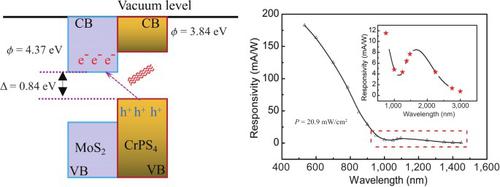Nano Research ( IF 9.5 ) Pub Date : 2021-09-16 , DOI: 10.1007/s12274-021-3790-4 Guoliang Xu 1 , Danmin Liu 1 , Yi Wu 1 , Shaobo Wang 1 , Zikun Huang 1 , Songyu Li 2 , Zhenlu Zhang 3 , Yongzhe Zhang 4

|
Ternary two-dimentional (2D) materials exhibit diverse physical properties depending on their composition, structure, and thickness. Through forming heterostructures with other binary materials that show similar structure, there can be numerous potential applications of these ternary 2D materials. In this work, we reported the structure of few-layer CrPS4 by X-ray diffraction, transmission electron microscope, and electron-density distribution calculation. We also demonstrated a new application of the CrPS4/MoS2 heterobilayer: visible-infrared photodetectors with type-II staggered band alignment at room temperature. The response of the heterostructure to infrared light results from a strong interlayer coupling that reduces the energy interval in the junction area. Since the intrinsic bandgap of individual components determines wavelengths, the decrease in energy interval allows better detection of light that has a longer wavelength. We used photoluminescence (PL) spectroscopy, Kelvin probe force microscopy (KPFM) under illumination, and electrical transport measurements to verify the photoinduced charge separation between the CrPS4/MoS2 heterostructures. At forward bias, the device functioned as a highly sensitive photodetector, as the wavelength-dependent photocurrent measurement achieved the observation of optical excitation from 532 to 1,450 nm wavelength. Moreover, the photocurrent caused by interlayer exciton reached around 1.2 nA at 1,095 nm wavelength. Our demonstration of the strong interlayer coupling in the CrPS4/MoS2 heterostructure may further the understanding of the essential physics behind binary-ternary transition metal chalcogenides heterostructure and pave a way for their potential applications in visible-infrared devices.
中文翻译:

范德华II型异质结构中二元-三元过渡金属硫属化物层间耦合,用于具有有效抑制暗电流的可见红外光电探测器
三元二维 (2D) 材料根据其成分、结构和厚度表现出不同的物理特性。通过与具有相似结构的其他二元材料形成异质结构,这些三元二维材料可以有许多潜在的应用。在这项工作中,我们通过 X 射线衍射、透射电子显微镜和电子密度分布计算报告了少层 CrPS 4的结构。我们还展示了 CrPS 4 /MoS 2的新应用异质双层:在室温下具有 II 型交错带对齐的可见红外光电探测器。异质结构对红外光的响应来自于减小结区能量间隔的强层间耦合。由于单个组件的固有带隙决定了波长,因此能量间隔的减小可以更好地检测具有更长波长的光。我们使用光致发光 (PL) 光谱、照明下的开尔文探针力显微镜 (KPFM) 和电传输测量来验证 CrPS 4 /MoS 2之间的光致电荷分离异质结构。在正向偏压下,该器件用作高灵敏度光电探测器,因为依赖于波长的光电流测量实现了对 532 至 1,450 nm 波长的光激发的观察。此外,层间激子引起的光电流在 1,095 nm 波长下达到约 1.2 nA。我们对 CrPS 4 /MoS 2异质结构中强层间耦合的展示可能会进一步了解二元-三元过渡金属硫属元素化物异质结构背后的基本物理原理,并为其在可见红外器件中的潜在应用铺平道路。











































 京公网安备 11010802027423号
京公网安备 11010802027423号